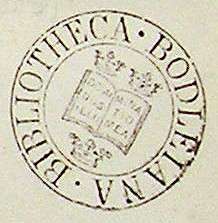Thomas Hyde
Thomas Hyde (29 June 1636 – 18 February 1703) was an English orientalist. The first use of the word dualism is attributed to him, in 1700.[1]
Life
He was born at Billingsley, near Bridgnorth in Shropshire, on 29 June 1636. He inherited his taste for linguistic studies, and received his first lessons in some of the Eastern tongues, from his father, who was rector of the parish.
Hyde was educated at Eton College, and in his sixteenth year entered King's College, Cambridge.[2] There, under Abraham Wheelock, professor of Arabic, he made rapid progress in Oriental languages, so that, after only one year of residence, he was invited to London to assist Brian Walton in his edition of the Polyglott Bible. Besides correcting the Arabic, Persic and Syriac texts for that work, Hyde transcribed into Persic characters the Persian translation of the Pentateuch, which had been printed in Hebrew letters at Constantinople in 1546. To this work, which Archbishop Ussher had thought well-nigh impossible even for a native of Persia, Hyde appended the Latin version which accompanies it in the Polyglott.
In 1658 he was chosen Hebrew reader at Queen's College, Oxford, and in 1659, in consideration of his erudition in Oriental tongues, he was admitted to the degree of M.A. In the same year he was appointed under-keeper of the Bodleian Library, and in 1665 librarian-in-chief. Next year he was collated to a prebend at Salisbury, and in 1673 to the archdeaconry of Gloucester, receiving the degree of D.D. shortly afterwards. As librarian, Hyde was responsible for the publication of the Catalogus impressorum Librorum Bibliothecae Bodleianae (1674), the third published catalogue of the Bodleian collections.
In 1691 the death of Edward Pococke opened up to Hyde the Laudian professorship of Arabic; and in 1697, on the deprivation of Roger Altham, he succeeded to the Regius chair of Hebrew and a canonry of Christ Church.
Under Charles II, James II and William III, Hyde discharged the duties of Eastern interpreter to the court. He resigned his librarianship in 1701, giving as a reason, "my feet being left weak by the gout, I am weary of the toil and drudgery of daily attendance all times and weathers."[3] He died at Oxford on 18 February 1703.
Works
Hyde, who was one of the first to direct attention to the vast treasures of Oriental antiquity, was an excellent classical scholar, and there was hardly an Eastern tongue accessible to foreigners with which he was not familiar. He had even acquired Chinese from the Chinese Jesuit Michael Shen Fu-Tsung,[4][5] while his writings are the best testimony to his mastery of Turkish, Arabic, Syriac, Persian, Hebrew and Malay.
In his chief work, Historia religionis veterum Persarum (1700), he made the first attempt to correct from Oriental sources the errors of the Greek and Roman historians who had described the religion of the ancient Persians. He identified Zoroaster as a religious reformer.[6]
His other writings and translations comprise Tabulae longitudinum et latitudinum stellarum fixarum ex observatione principis Ulugh Beighi (1665), to which his notes have given additional value; Quatuor evangelia et acta apostolorum lingua Malaica, characteribus Europaeis (1677); Epistola de mensuris et ponderibus serum sive sinensium (1688), appended to Edward Bernard's De mensuris et ponderibus antiquis; Abraham Peritsol's Itinera mundi (1691); and De ludis orientalibus libri II (1694) in which he described various Chinese games including Coan ki and where he gave also the first full Latin description of weiqi.[7]
With the exception of the Historia religionis, which was republished by Hunt and Costard in 1760, the writings of Hyde, including some unpublished manuscripts, were collected and printed by Dr. Gregory Sharpe in 1767 under the title Syntagma dissertationum quas olim Thomas Hyde separatim edidit. There is a life of the author prefixed.
See also
Notes
- ↑ HYDE, Thomas. Veterum Persarum et Parthorum et Medorum Religionis Historia. Editio Secunda, MDCCLX.
- ↑ "Hyde, Thomas (HD652T)". A Cambridge Alumni Database. University of Cambridge.
- ↑ William D. Macray, Annals of the Bodleian Library (1868) p. 121-122.
- ↑ Lewis A. Maverick, review of A Cycle of Cathay: The Chinese Vogue in England During the Seventeenth and Eighteenth Centuries, by William W. Appleton. In The Far Eastern Quarterly, Vol. 11, No. 2 (Feb. 1952), pp. 246–247
- ↑ Ballaster, p.262
- ↑ Iranica.Com – Zoroaster – As Perceived In Western Europe After Antiquity
- ↑ De Ludis Orientalibus Libri Duo: Historia Nerdiludii, hoc est dicere, Trunculorum : cum quibuidam aliis Arabum, Persarum ... & aliarum Gentium Ludis tam Politicis quam Bellicis ... additis omnium Nominibus in dictarum Gentium Linguis. Ubi etiam Classicorum Graecorum & Latinorum loca ... est explicantur. Item, Explicatio amplissimi Chinensium Ludi, qui eorum Politiam & modum perveniendi ad Dignitates in Aula Regia exponit, & egregio ac peramplo Schemate repraesentat, Oxonii, E Theatro Sheldoniano, 1694, Vol. 2, pp. 195-201
 This article incorporates text from a publication now in the public domain: Chisholm, Hugh, ed. (1911). "Hyde, Thomas". Encyclopædia Britannica. 14 (11th ed.). Cambridge University Press. p. 30.
This article incorporates text from a publication now in the public domain: Chisholm, Hugh, ed. (1911). "Hyde, Thomas". Encyclopædia Britannica. 14 (11th ed.). Cambridge University Press. p. 30.
External links
- "Archival material relating to Thomas Hyde". UK National Archives.
- Works by or about Thomas Hyde in libraries (WorldCat catalog)
